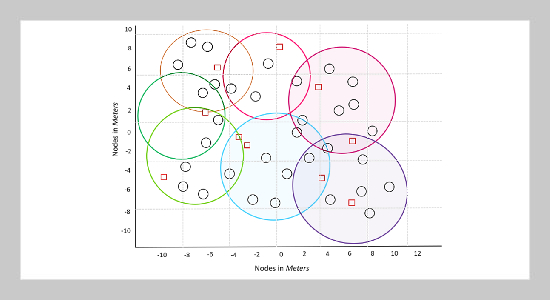- [1] B. Großwindhager, M. Rath, M. S. Bakr, P. Greiner, C. A. Boano, K. Witrisal, F. Gentili, J. Grosinger, W. Bösch, and K. Römer, (2019) “Dependable Wire�less Communication and Localization in the Internet of Things" Mission-Oriented Sensor Networks and Systems: Art and Science: Volume 2: Advances: 209– 256. DOI: 10.1007/978-3-319-92384-0_7.
- [2] T. T. T. Le and S. Moh, (2015) “Interference mitiga�tion schemes for wireless body area sensor networks: A comparative survey" Sensors 15: 13805–13838. DOI: 10.3390/s150613805.
- [3] Z. Xie, B. Wang, J. Yu, H. Wu, G. Huang, R. Zarei, and J. He, (2020) “An optimal backoff time-based inter�network interference mitigation method in wireless body area network" Journal of Sensors: 1–13. DOI: 10.1155/2020/4365191.
- [4] T. T. T. Le and S. Moh, (2016) “An interference-aware traffic-priority-based link scheduling algorithm for in�terference mitigation in multiple wireless body area net�works" Sensors 16: 2190.
- [5] H. B. Elhadj, S. Boudjit, L. Chaari, and L. Kamoun. “IEEE 802.15. 6 based node and hub architectures for healthcare applications”. In: IEEE, 2014, 1–3. DOI: 10.1109/WD.2014.7020848.
- [6] F. N. Khan, R. Ahmad, W. Ahmed, M. M. Alam, and M. Drieber. “Performance Analysis of Interference and Priority aware Coexistence in IEEE 802.15. 6 based WBANs”. In: IEEE, 2020, 1–5. DOI: 10.1109/ BEC49624.2020.9277066.
- [7] F. Ullah, A. H. Abdullah, M. Q. Jan, and K. N. Qureshi, (2016) “Patient data prioritization in the cross�layer designs of wireless body area network" Journal of Computer Networks and Communications: 5. DOI: 10.1155/2015/516838.
- [8] H. Li, B. Yang, W. Yu, X. Guan, X. Gong, and G. Yu. “Joint sleep scheduling and opportunistic transmis�sion in wireless body area networks”. In: IEEE, 2014, 1886–1891.
- [9] J. A. Paradiso and T. Starner, (2005) “Energy scaveng�ing for mobile and wireless electronics" IEEE Pervasive computing 4: 18–27. DOI: 10.1109/MPRV.2005.9.
- [10] J. Ferreira, I. Pau, K. Lindecrantz, and F. Seoane, (2016) “A handheld and textile-enabled bioimpedance sys�tem for ubiquitous body composition analysis. An initial functional validation" IEEE journal of biomedical and health informatics 21: 1224–1232.
- [11] J. O. Ha, S. H. Jung, M. C. Park, K. H. Lee, and Y. S. Eo. “A fully integrated 3–5 GHz UWB RF transceiver for WBAN applications”. In: IEEE, 2013, 1–3.
- [12] K.-J. Wu, Y.-W. P. Hong, and J.-P. Sheu, (2020) “Coloring-based channel allocation for multiple coexisting wireless body area networks: A game-theoretic approach" IEEE Transactions on Mobile Computing 21: 63–75.
- [13] X. Nan, X. Wang, T. Kang, J. Zhang, L. Dong, J. Dong, P. Xia, and D. Wei, (2022) “Review of flexible wear�able sensor devices for biomedical application" Microma�chines 13: 1395.
- [14] A. Lay-Ekuakille, G. Griffo, P. Vergallo, A. Massaro, F. Spano, and G. Gigli, (2015) “Implantable neurorecord�ing sensing system: Wireless transmission of measure�ments" IEEE Sensors Journal 15: 2603–2613.
- [15] T. T. T. Le and S. Moh, (2018) “Hybrid multi-channel MAC protocol for WBANs with inter-WBAN interference mitigation" Sensors 18: 1373.
- [16] M. M. Alam and E. B. Hamida, (2014) “Surveying wearable human assistive technology for life and safety critical applications: Standards, challenges and opportuni�ties" Sensors 14: 9153–9209.
- [17] M. Sahraoui and A. Bilami. “A new Reinforcement Learning based for Energy-efficient Multi-channel Data Gathering in Wireless Sensor Networks”. In: IEEE, 2020, 1–7.
- [18] Q. Wu, Y. Xu, L. Shen, and J. Wang, (2012) “Investi�gation on GADIA algorithms for interference avoidance: A game-theoretic perspective" IEEE Communications Letters 16: 1041–1043.
- [19] M. Thachayani. “Interference mitigation scheme to support WBANs Co-existing with WLANs”. In: IEEE, 2019, 41–44.
- [20] N. Naji, M. R. Abid, N. Krami, and D. Benhaddou, (2021) “Energy-Aware Wireless Sensor Networks for Smart Buildings: A Review" Journal of Sensor and Actuator Networks 10: 67.
- [21] S. Asaithambi, L. Ravi, H. Kotb, A. H. Milyani, A. A. Azhari, S. Nallusamy, V. Varadarajan, and S. Vairava�sundaram, (2022) “An Energy-Efficient and Blockchain�Integrated Software Defined Network for the Industrial Internet of Things" Sensors 22: 7917.
- [22] S. Movassaghi, M. Abolhasan, J. Lipman, D. Smith, and A. Jamalipour, (2014) “Wireless body area networks: A survey" IEEE Communications surveys & tutorials 16: 1658–1686.
- [23] S. Movassaghi, A. Majidi, A. Jamalipour, D. Smith, and M. Abolhasan, (2016) “Enabling interference-aware and energy-efficient coexistence of multiple wireless body area networks with unknown dynamics" IEEE Access 4: 2935–2951.
- [24] T. Benmansour, T. Ahmed, and S. Moussaoui. “Per�formance evaluation of IEEE 802.15. 6 MAC in moni�toring of a cardiac patient”. In: IEEE, 2016, 241–247.
- [25] T. Kang, S. Kim, K.-I. Oh, J.-H. Hwang, J. Lee, H. Park, K. Byun, and W. Lee, (2020) “Evaluation of human body characteristics for electric signal transmission based on measured body impulse response" IEEE transactions on instrumentation and measurement 69: 6399–6411.
- [26] T. Wu, F. Wu, J.-M. Redoute, and M. R. Yuce, (2017) “An autonomous wireless body area network implementa�tion towards IoT connected healthcare applications" IEEE access 5: 11413–11422.
- [27] V. Cionca, T. Newe, and V. Dadârlat. “TDMA proto�col requirements for wireless sensor networks”. In: IEEE, 2008, 30–35.
- [28] W. Ye, J. Heidemann, and D. Estrin, (2004) “Medium access control with coordinated adaptive sleeping for wire�less sensor networks" IEEE/ACM Transactions on net�working 12: 493–506.
- [29] Y. Zatout, E. Campo, and J.-F. Llibre. “T-tmac: Energy aware sensor mac protocol for health-care monitor�ing”. In: IEEE, 2012, 1–5.
- [30] Z. Askari, J. Abouei, M. Jaseemuddin, and A. An�palagan, (2021) “Energy-efficient and real-time NOMA scheduling in IoMT-based three-tier WBANs" IEEE In�ternet of Things Journal 8: 13975–13990.
- [31] Z. Ullah, I. Ahmed, K. Razzaq, M. K. Naseer, and N. Ahmed, (2019) “DSCB: Dual sink approach using clus�tering in body area network" Peer-to-Peer Networking and Applications 12: 357–370.
- [32] S. Essafi and T. Ezzedine, (2018) “Adaptive parameters adjustment in WBAN to mitigate Wi-Fi interferences" Journal of computing and information technology 26: 69–83.
















